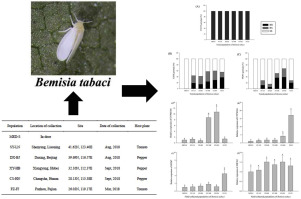当前位置:
X-MOL 学术
›
Pestic. Biochem. Phys.
›
论文详情
Our official English website, www.x-mol.net, welcomes your
feedback! (Note: you will need to create a separate account there.)
Monitoring insecticide resistance and diagnostics of resistance mechanisms in Bemisia tabaci Mediterranean (Q biotype) in China
Pesticide Biochemistry and Physiology ( IF 4.2 ) Pub Date : 2020-02-01 , DOI: 10.1016/j.pestbp.2019.11.003 Ran Wang 1 , Wunan Che 2 , Jinda Wang 3 , Chen Luo 1
Pesticide Biochemistry and Physiology ( IF 4.2 ) Pub Date : 2020-02-01 , DOI: 10.1016/j.pestbp.2019.11.003 Ran Wang 1 , Wunan Che 2 , Jinda Wang 3 , Chen Luo 1
Affiliation

|
Bemisia tabaci is one of notorious agricultural insect pests in China, and the strategies of management largely depend on application of insecticides. In order to assess levels of resistance in field populations of B. tabaci to six insecticides including abamectin, cyantraniliprole, pymetrozine, imidacloprid, chlorpyrifos and bifenthrin, we monitored the susceptibility to all tested insecticides in five field populations across China and the results indicated that field populations of B. tabaci have developed various levels of resistance to each chemical agent. Furthermore, para-type voltage gated sodium channel mutations (L925I and T929V) and acetylcholinesterase ace1 mutation (F331W) were confirmed, and expression levels of CYP6CM1, CYP4C64, GSTd7 and ABCG3 were detected for investigating mechanisms of imidacloprid resistance in the five field-collected populations. The results showed that, in all tested populations, frequencies of F331W were 100%, and the frequencies of the L925I and T929V were in the range of 28.5 to 47.0% and 11.0 to 53.5%, respectively. Moreover, CYP6CM1 and CYP4C64 were significantly overexpressed in two tested populations, respectively, and GSTd7 was significantly overexpressed in one population. No overexpression of ABCG3 was observed in all the populations. Above results provided valuable insight into the current status of insecticide resistance and could be contributed to design strategies of management for B. tabaci.
更新日期:2020-02-01











































 京公网安备 11010802027423号
京公网安备 11010802027423号